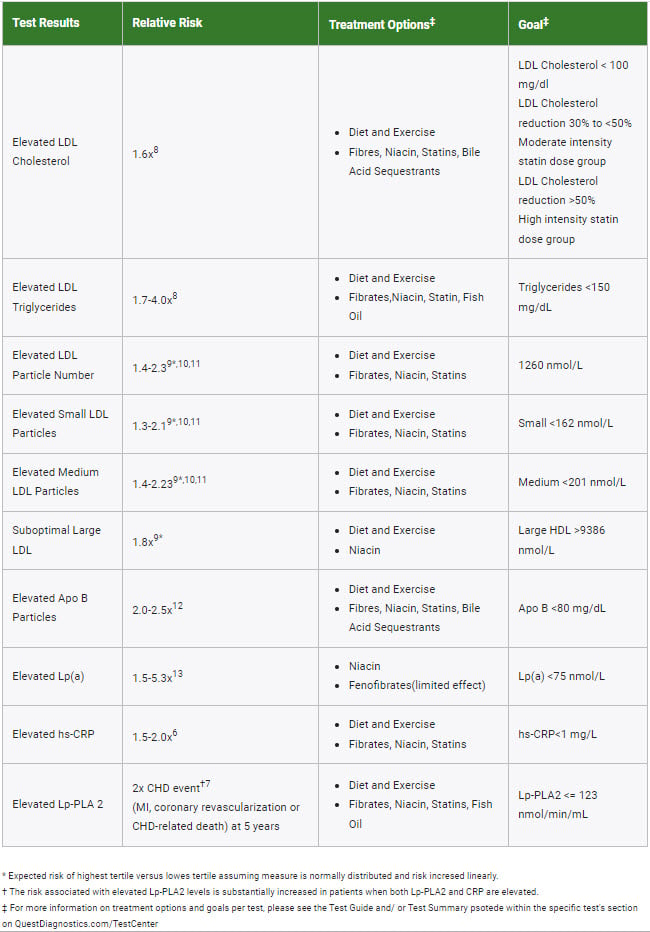Cardio IQ Advanced Lipid Panel

The Cardio IQ® Report provides an in-depth assessment of cardiovascular risks to help physicians recommend the ideal individualized treatment option for patient to minimize cardiovascular disease.
The report is simple, yet comprehensive. It is color-coded to display progressive risk values versus goal using “optimal,” “moderate,” and “high-risk” categories and grouped by functional categories.
Cardio IQ Advanced Lipid Panel The Cardio IQ Advanced Lipid Panel includes:Total Cholesterol, Triglycerides, HDL, LDL and Cholesterol/HDL ratio, LDL Particle Number, LDL Peak Size, LDL Pattern, HDL Large, LDL Small, LDL Medium, Apolipoprotein B, Lipoprotein (a). FASTING REQUIRED. Results for this test take 2 weeks to receive.
Table of Contents
- What Does the Cardio IQ Advanced Lipid Panel Measure?
- How Long Does it Take to Get Cardio IQ Panel Results?
- How to Prepare for the Cardio IQ Test
- Why is Cardio IQ Advanced Lipid Panel More Useful than a Simple Lipid Panel?
- What to Do to Improve Cardio IQ Advanced Lipid Panel Abnormal Results?
- HOW DOES DISCOUNTEDLABS.COM WORK?
What Does the Cardio IQ Advanced Lipid Panel Measure?
The Cardio IQ Advanced Lipid Panel includes:
- Total Cholesterol, Triglycerides, HDL, LDL and Cholesterol/HDL ratio
- LDL Particle Number (LDL-P): The number of low-density lipoprotein (LDL) particles in the blood is measured by LDL-P. Each LDL particle carries cholesterol and triglycerides to tissues all over the body. Studies have shown that a higher LDL-P count is a better indicator of heart disease risk than LDL cholesterol (LDL-C) alone. This is because a high LDL-P count means that there are more particles that cause plaque to form in the bloodstream.
- LDL Peak Size: The LDL peak size is how the size of LDL particles in the blood is spread out. Based on their size, LDL particles can be put into two main groups: small, dense LDL particles (sdLDL) and large, buoyant LDL particles. Smaller, denser LDL particles are thought to be more atherogenic because they can get deeper into arterial walls, are more likely to oxidize, and have less of a pull on LDL receptors. So, a smaller LDL peak size is linked to an increased risk of heart disease.
- LDL Pattern: The LDL pattern is the type of LDL particles that are most common in the blood, either Pattern A (large, buoyant LDL particles) or Pattern B (small, dense LDL particles) (small, dense LDL particles). Small, dense LDL particles cause atherosclerosis, which means that people with Pattern B are more likely to have heart disease.
- HDL Large: HDL large is a subclass of high-density lipoprotein (HDL) particles that are bigger. Large HDL particles are thought to protect the heart because they are better at removing cholesterol from cells (cholesterol efflux) and moving cholesterol away from cells (reverse cholesterol transport) (transporting cholesterol from peripheral tissues back to the liver for excretion). Heart disease is less likely to happen if you have a lot of large HDL particles in your blood.
- LDL Small: LDL small means small, dense LDL particles, which are more likely to cause atherosclerosis than large, buoyant LDL particles. High levels of small LDL particles are linked to a higher risk of cardiovascular disease because they can get into arterial walls more easily and cause plaque to form.
- LDL Medium: The LDL particles that are in between the small, dense LDL and the big, floaty LDL are called LDL medium. When compared to the other two subclasses, these particles have a middle level of atherogenic potential. Less is known about the clinical importance of medium-sized LDL particles, but it is important to think about them as a part of the whole LDL particle profile.
- Apolipoprotein B (ApoB): ApoB is the main protein in all atherogenic lipoproteins, like LDL, VLDL, and IDL (IDL). One ApoB molecule is in each atherogenic particle. By measuring ApoB levels, you can get an idea of how many atherogenic particles are in your blood. Heart disease is more likely to happen if you have a high level of ApoB.
- Lipoprotein (a) (Lp(a)) is a lipoprotein that has the same structure as LDL, but Apo(a) is attached to ApoB instead of ApoB alone. Lp(a) makes atherosclerosis worse by making plaques and slowing down fibrinolysis (the breakdown of blood clots). High Lp(a) levels are a risk factor for cardiovascular disease on their own, and this risk is mostly caused by genes.
By looking at these lipid markers, doctors can get a better idea of a patient's risk for cardiovascular disease and make treatment plans that focus on specific lipid abnormalities. This all-around approach could help lower the overall risk of getting heart disease.
How Long Does it Take to Get Cardio IQ Panel Results?
Results for this test take 2 weeks to receive.
How to Prepare for the Cardio IQ Test
It is recommended to fast for 12-14 hours before getting your blood drawn for this test.
Why is Cardio IQ Advanced Lipid Panel More Useful than a Simple Lipid Panel?
The Cardio IQ® Report provides an in-depth assessment of cardiovascular risks to help physicians recommend the ideal individualized treatment option for patient to minimize cardiovascular disease.
The report is simple, yet comprehensive. It is color-coded to display progressive risk values versus goal using “optimal,” “moderate,” and “high-risk” categories and grouped by functional categories.
This advanced test uses a technology called Ion mobility. This test goes far beyond your basic lipid test, for starters this test helps to reclassify a patient’s cardiovascular risk. Nearly half of all heart attack patients were found to have no prior risk which would indicate they were heading toward an attack. Cardio IQ Ion Mobility tests directly detects, measures and quantifies the number and size of all lipoprotein subfractions. Knowing what particles make up your LDL and HDL cholesterol may be important. Ion Mobility Technology provides subclass separation that will allow your healthcare provider to identify your cardiovascular risk over time. Following the change in your lipid profile as you respond to diet, exercise and possible medication to reduce your cardiovascular risk is important. Ion Mobility provides the opportunity to determine if treatment is working and if not, optimize the aggressiveness of therapy to hopefully make a difference that can be seen in the Ion Mobility measurement and graphical representation of your LDL and HDL particles.
Ion mobility technology precisely quantifies lipoprotein fractions across the entire lipoprotein spectrum; this comprises very low-density lipoprotein (VLDL), intermediate-density lipoprotein (IDL), low-density lipoprotein (LDL), and high-density lipoprotein (HDL) particles. Ion mobility identifies 2 main subclasses of HDL: large HDL and small HDL. The antioxidant properties of large HDL may help protect the arterial wall. A decreased large HDL subclass has historically suggested increased CVD risk.
An elevated total LDL particle number is associated with a 1.2 to 1.4-fold increase in cardiovascular disease risk. Similarly, elevated small and medium LDL particle numbers have been associated with a 1.2 to 1.4-fold increase.
What to Do to Improve Cardio IQ Advanced Lipid Panel Abnormal Results?
The following table shows what to do when any of the lab test results shown by your Cardio IQ test is abnormal.

DiscountedLabs.com offers affordable blood tests you can order online in the United Sates without the need of a doctor's order. We have no hidden fees and have an easy ordering process.
HOW DOES DISCOUNTEDLABS.COM WORK?
-
Go to the "Find a Location" page to find the closest lab location. No need to make an appointment since walk-ins are welcomed. Once you have identified your closest location, go to step 2.
-
Go to "Choose a Test" and add your selection (s) in the shopping cart. If you prefer to save money on bundled tests, we have created "Lab Test Panels" that can help you decide what to order.
-
If you have a discount coupon code, add it to your cart.
-
A $8 lab processing fee will be added to your total.
-
Pay using a credit card.
-
You will receive an order confirmation and instructions email on how to download your lab request.
-
Print lab request form that you downloaded.
-
Take that form to the closest lab location with a picture ID. Get your blood drawn.
-
You will receive an email when the results are ready for you to download.
Note: You cannot place an order under someone else's profile. The profile person's name will appear on the lab order form.If you have further questions, please email [email protected].
HOW DOES DISCOUNTEDLABS.COM WORK?
-
Go to the "Find a Location" page to find the closest lab location. No need to make an appointment since walk-ins are welcomed. Once you have identified your closest location, go to step 2.
-
Go to "Choose a Test" and add your selection (s) in the shopping cart. If you prefer to save money on bundled tests, we have created "Lab Test Panels" that can help you decide what to order.
-
If you have a discount coupon code, add it to your cart.
-
A $8 lab processing fee will be added to your total.
-
Pay using a credit card.
-
You will receive an order confirmation and instructions email on how to download your lab request.
-
Print lab request form that you downloaded.
-
Take that form to the closest location. Get your blood drawn.
-
You will receive an email when the results are ready for you to download.
Note: You cannot place an order under someone else's profile. The profile person's name will appear on the lab order form.If you have further questions, please email [email protected].
